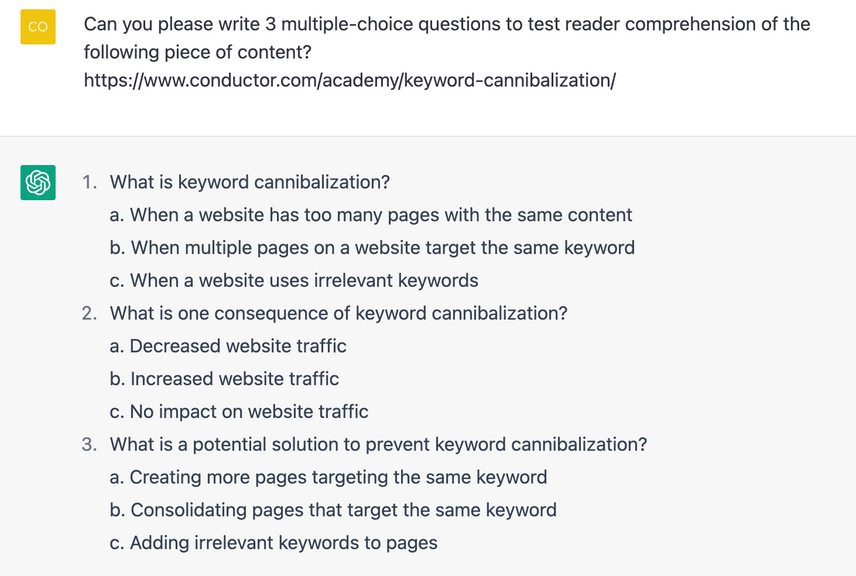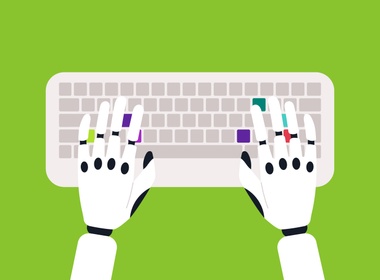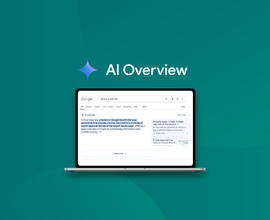Everything You Need to Know About AI-Generated Content
AI-generated content, or AI-created content as it’s also called, is a type of computer-generated copy that can replicate human writing and thinking. AI content generators take many forms and can write entire pieces of content—like articles and social media posts—or help brainstorm by simulating human interaction in a chat. Regardless of how you use it, AI-generated content is only growing more relevant, so it pays to learn the best way to leverage it.
AI has been a particularly hot topic lately, and it’s only growing in popularity with what seems like everyone sharing their opinion about tools like ChatGPT and what it means for the future of content—and for the more dramatic of you—humanity as we know it. No one knows where AI content tools will bring us tomorrow—especially as updates to tools like ChatGPT continue to pour in—but today, it’s a tool that could help boost your content creation process and automate many tedious tasks in your day-to-day workflows.
Let me assuage your fears now: this will not be another article that speculates wildly about where AI will bring us in 5 years. Instead, we’ll dive into what AI chatbots and content generators actually do and actionable strategies on how to add AI to your existing workflows.
What is AI-generated content?
AI-generated content describes pieces of writing or designs that were created by machine learning based on human inputs rather than traditional content creation. This could include creating anything from long-form articles to Facebook ad copy. Some tools even offer AI image generation.
Although ChatGPT has gotten most of the headlines lately, there are several different kinds of AI tools that can help generate content. Odds are that you have used one yourself in the past, whether it’s a chatbot like ChatGPT or a tool like Grammarly, which uses AI to help improve your content’s readability and grammar. Really, AI’s inclusion in the content creation process is nothing new, it's just being implemented in new ways.
How does AI-generated content work?
This will probably happen a few times throughout this piece, but I’ll let ChatGPT speak for itself here. This was ChatGPT’s response to my request for it to “explain how AI content generation tools work.” “AI content generation tools use machine learning algorithms, often based on natural language processing, to analyze large datasets of text and learn how to generate new content that is similar in style and tone.”
Natural language processing (NLP) involves training a machine learning algorithm with hundreds of datasets from books, articles, and other content to understand the nuances of language, such as grammar, syntax, and word choice. This means that ChatGPT essentially “predicts” the likelihood that different words will appear based on a user’s input text.
What’s with all the hype around AI-generated content?
Well, if you talk to any given university student, the hype around AI and ChatGPT is that they’ll never have to write a paper again—we’ll get to how this isn’t true later. But outside of universities, why has there been so much chatter about ChatGPT lately? ChatGPT isn’t magic after all, but like any machine, it’s very effective at doing certain manual tasks for you, whether that task is writing an entire case study or doing keywordKeyword
A keyword is what users write into a search engine when they want to find something specific.
Learn more research.
For instance, I used ChatGPT to help get ideas on how to write this very article you’re reading. The meta descriptionMeta Description
The meta description is one of a web page’s meta tags. With this meta information, webmasters can briefly sketch out the content and quality of a web page.
Learn more for this article? Brought to you with the help of ChatGPT. Whether your workflows include writing email subject lines or creating a list of the best snowboards, with the right prompt, AI tools, and chatbots can help remove a lot of tedium from day-to-day tasks.
What AI-generated content means for content creators
The popularity of ChatGPT and other AI content generators has renewed fears that AI will replace people, in this case, content creators. While it’s true that AI tools can create an entirely new piece of content in a fraction of the time it takes a human, it does not directly replace writers and designers. In short, don’t panic. The sky isn’t falling. In fact, this actually presents an opportunity for content creators to grow.
AI is a tool, and chatbots and content generators are invaluable tools for writers and designers. Here’s a concrete example. A guard uses cameras to keep an area secure. The cameras work autonomously but don’t replace the need for a security guard, they simply make the guard’s job easier. Just like using AI for content creation, which can help with anything from brainstorming ideas to optimizing content.
An aspect of that example that you shouldn’t overlook is the fact that the cameras don’t replace the need for a security guard. A camera still needs a human to act on the information it provided, and AI-generated content is no different. Whether you’re using ChatGPT or Grammarly, AI tools are imperfect. Several times while writing this, Grammarly gave me suggestions that changed the meaning of sentences or made phrasing unclear. ChatGPT and other AI chatbots are similar in that they sometimes offer incorrect, or in some cases harmful, information, and it falls to the writers to be vigilant and correct the copy as needed.
Like I said, I used ChatGPT to help with parts of this article. I used AI for keyword research, as well as creating meta tags and other critical SEO details. These tools work quickly and simplify workflows, which means they aren’t going anywhere. So the question you should be asking yourself isn’t whether AI is worth incorporating into your practices, but rather, what the best way to leverage AI is for you.
What AI-generated content means for SEOs
Like content creators, SEOs stand to benefit a lot from including AI in their workflows. While the use cases will be different, any SEO will tell you that their day-to-day is filled with tedious tasks that hurt productivity. From a workflow perspective, SEOs can use AI content and chatbot tools to automate things like keyword research, pulling and organizing data, and creating title tags and meta descriptions for upcoming content.
Beyond that, AI content generators, and chatbots specifically, are great for helping to brainstorm ideas and get inspiration. For instance, you could ask ChatGPT to create a list of the 10 best marketing podcasts or the best youtube videos on the state of the search industry. Which could provide inspiration for future content topics, as well as help you grow in your career.
Benefits and limitations of AI-generated content
Stop me if I’ve mentioned this before, but ChatGPT and other AI content generators are tools. Like any other tool, this technology has significant benefits to help you complete tedious tasks, but also several limitations you should be aware of.
Benefits of AI-generated content
- Ease of use
ChatGPT and other tools like it are open to the public and in many cases, free to use. Anyone can start using these tools right now and get answers to almost anything that comes to mind. All you need is to create an account, and you can start playing around with the technology and finding the ways it could work best for you. - Quick turnaround time
ChatGPT will provide content based on your specific inputs almost instantly, depending on the complexity of the task. ChatGPT replies to most requests within a few minutes, even to something complex. For example, I asked ChatGPT to explain what a W2 form is and got a four-paragraph response in under a minute. So AI can keep even your most complex workflows more agile. - Good source of inspiration
AI content generators are very helpful in providing ideas for your content. For instance, I could ask ChatGPT to provide me with 5 title options for this article, and within moments, I have a list of ideas for titles to work from and revise as needed.
Limitations of AI-generated content
Despite what you may have heard, ChatGPT can’t actually do everything. While it speeds up tedious workflows and creates content in a breeze, it is not without faults. In fact, the limitations of the tool are listed on the ChatGPT site, warning that it may occasionally provide incorrect or harmful information. Before you start leveraging ChatGPT and similar tools in your content strategy, you have to understand where it may lead you astray.
- Content doesn’t have a human touch
This is the big one, so let’s start here. It’s true that AI can create high-quality, readable content very quickly, but what it can’t do is satisfy audience search intent with consistency. We know that Google promotes helpful, high-quality content that satisfies user search intent, so providing that content will only become more important if sites start pumping out slightly different ai-generated content. Essentially, AI content generators can help provide the framework for a piece of content, but in order to really provide something unique and impactful, you will always need to devote time and effort to proofing, re-writing, and finding the heart in your content. - The tool may occasionally generate incorrect information
These are ChatGPT’s own words. In the user interface, ChatGPT warns that the information the tool provides isn’t 100% accurate all the time. While we just went over how ChatGPT can be a hugely helpful research tool, it’s important to keep in mind that every once in a while it is also prone to mistakes—who among us isn’t, am I right?—which only reinforces the need for human oversight of your AI-generated content. Or, as ChatGPT phrased it itself: “These tools can be used to create various types of content, but their effectiveness is not always as nuanced or effective as content created by human writers.” - The tools have built-in biases
AI-powered content generators, like ChatGPT, are trained to be helpful, truthful, and harmless. These are intentional biases built into the system, which could sometimes cause the tools to avoid negativity in their writing and provide a more neutral tone. While this can be helpful in some cases where a more measured tone is required, AI tools can struggle with things such as speaking about something positively or negatively. - Unaware of current events
Many AI content tools are purposely not taught about current events. ChatGPT, for instance, has no information more recent than 2021. This is important to keep in mind if you’re creating fresh or timely content, and it further solidifies the fact that these tools may provide incorrect or unhelpful information at times.
Perhaps it’s best to let OpenAI, the power behind ChatGPT and GPT-4, to speak on the limitations for itself . “Despite its capabilities, GPT-4 has similar limitations as earlier GPT models. Most importantly, it still is not fully reliable (it “hallucinates” facts and makes reasoning errors). Great care should be taken when using language model outputs, particularly in high-stakes contexts…”
In short, you’ll get out of AI content generators what you put into them. If you’re a skilled writer with a very detailed request for ChatGPT, you’ll probably be satisfied with the results. Whereas if you provide AI with vague ideas or incomplete thoughts, the resulting copy won’t be as strong as it can be.
How Google views AI-generated content
Speculation has been rampant around AI-generated content and ChatGPT, but one area where you don’t need to speculate is in how Google views AI content. Google has provided specific guidelines for how to incorporate AI into your strategy and how it may affect your rankingsRankings
Rankings in SEO refers to a website’s position in the search engine results page.
Learn more.
Google wrote: “Our focus on the quality of content, rather than how content is produced, is a useful guide that has helped us deliver reliable, high-quality results to users for years.” So the key thing to keep in mind, like with all content on Google, is to create customer-first content that users find helpful. Google will promote helpful content even if it’s been produced with the help of AI, however, if you leverage AI to create spammy or unhelpful content, your rankings will likely suffer.
How consumers feels about AI-generated content
Since Google promotes content that consumers will find helpful, it’s fair to wonder whether your audience finds AI-generated content to be helpful. A recent study by Dentsu surveyed 1,000 people to get their thoughts and feelings on AI. Among their findings were two key takeaways for brands.
- Consumers want brands to use AI responsibly.
- Consumers want transparency when brands are using AI.
77% of respondents believe that brands should ensure existing biases and systems of inequality are not propagated by the AI they leverage. And roughly 75% of respondents believe that brands should disclose when AI is being used for any product design, content creation, or customer interaction.
So before you go incorporating AI into every piece of your strategy, make sure you’ve planned carefully.
How to check if content is AI-generated
Imagine for a second that you’re working with a new freelancer to write a blog post that you’re hoping will drive significant organic traffic. The freelancer uses ChatGPT to do most of the work before sending the draft back to you. You review the work and make some edits so the copy sounds a bit less mechanical, and then publish and wait for the traffic to roll in.
Now, while Google doesn’t automatically penalize AI-generated content in SERPs, it does penalize content that reads as unhelpful, spammy, or robotic, and it gets better at detecting these signals seemingly every year. In these cases, when traffic can be impacted, it pays to use tools to help you detect AI content rather than leave it all up to your own editing prowess.
In response to the growing popularity of ChatGPT and other AI content generators, several companies like Writer as well as OpenAI themselves, have rolled out technology and tools to detect if content is AI-generated.
How to incorporate AI-generated content into your content marketing strategy
AI content generators are absolutely worth mixing into your content strategy. It’s a great tool to have in your toolbox that helps you automate the tedious tasks that take up your days and offer real value in terms of brainstorming and planning out projects. When used wisely, AI chatbots and content generators are very helpful in supplementing and accelerating certain workflows, so there is a place for AI in your strategy somewhere.
But, like anything else, you need to find a way to balance a new workflow with your existing strategy. Things you should consider when deciding to use AI include things like team size and bandwidth. AI won't fill a gap in your headcount or resourcing. If you can’t dedicate the proper time and effort to reviewing and editing AI content, you’ll be better served using AI for smaller tasks, like research and brainstorming rather than long-term content generation. Below we’ll get into some more specific use cases for AI-generated content.
Potential risks of AI-generated content
Beyond the limitations to AI content that we’ve already mentioned, there is a risk of using content generators too much. If you use these tools too much to create net new content, your site’s content could start to read as robotic, sterile, cookie-cutter, and lacking a unique or new perspective on a topic, which describes the content that Google does not look to promote on SERPs.
Another pitfall is plagiarism, and while a lot of attention and speculation around plagiarism has been pointed toward high school and college campuses , this has already been an issue for some publications and journalists . Regardless of who uses ChatGPT and other tools for plagiarism, the risk remains the same. It’s never been easier for writers—and non-writers—to pass off bot-written work as their own. This is one thing if a writer is still taking the time to review the AI-generated work, but if that care isn’t taken, then the limitations of ChatGPT and other tools could be catastrophic for your content and brand reputation.
Finally, it’s important to be aware of the time it takes for writers and SEOs to review, proofread, and revise AI-generated content. Yes, ChatGPT produces written content very quickly, but like any first draft, it’s far from perfect. Any piece of content created this way will necessarily need to be reviewed and possibly revised by a human to make sure that the information is correct, readable, and helpful to users. Avoid these risks to boost your content strategy with AI.
Content marketing use cases for AI-generated content
While we’ve made it clear that AI-generated content shouldn’t replace traditional content creation, that’s not to say it can’t be used to make certain aspects of content creation easier. Always remember content generators, like ChatGPT, are tools meant to ease certain aspects of content creation, not handle the entire process. That said, below are some of the many ways we found that you can leverage AI and ChatGPT to streamline your workflows regardless of your role.
SEO use cases
- Keyword research: While you most likely have tools or platforms in place to perform keyword research, there is opportunity to further refine your research with AI. For example, when starting this article, I used ChatGPT to compile a keyword list and people also ask questions based on user search intent. From there, ChatGPT could have helped me to group keywords to make them more digestible, or even translate them to another language if need be.

- Content brief creation: Some AI tools offer functionality that helps you to automate the process of creating a content brief. Creating a content brief is critical to producing high-quality content, and the more thorough it is, the better the content will be. But, making a perfectly thorough content brief takes a lot of time, which few SEOs have at their disposal. This is why tools like Frase.io and Conductor’s actions feature help you automate the content brief process.
- Featured snippets: AI and ChatGPT can even help you steal featured snippet space from the competition. Using Conductor’s Content Guidance feature, you can find keywords that you rank well for but don’t own the featured snippet. From there, you can craft and review featured snippet copy in ChatGPT to make it superior to the competition. Once you publish, watch the results come in, and make tweaks as needed.
- Link building: Ask ChatGPT to “provide a list of the 5 best scholarly research articles about economic inflation.” And in just 10 seconds you’ll have a list of great resources to use in your research.

Content creation use cases
- Writing net new copy: At the risk of being repetitive, AI content generators can, indeed, write entire pieces of long- or short-form content from scratch. In fact, some AI content generators, like Frase, offer a specialized menu of AI tools. This saves time for obvious reasons, but again, this will still require a human eye to proof, revise, and optimize for user search intent.

- Revising existing content: Hand-in-hand with creating new content is optimizing the content you already have. And both Frase and ChatGPT can help rewrite and optimize your content in just a few moments. It’s as simple as copying and pasting your content and specifying how it should be revised.
- Image generation: A natural evolution of AI writing content is using AI for design. There is no shortage of AI image generators out there that can help you optimize images and boost your designs. For example, tools like Removal.ai can remove an unwanted background from an image, while others, like Vance , can enhance a poor or pixelated photo.
Technical use cases
- Coding and tag generation: AI content generators can even help you create rudimentary code for things like Schema markup, hreflang tags, and rules for robots.txt and redirects. Any SEO will tell you that these are, at best, tedious tasks that ChatGPT makes easy. Be sure to validate whatever the tool produces though!

- Creating RegEx rules: RegEx refers to a specific sequence of characters that helps you find patterns within text. For example, you can use regex to find matches for a specific character or number, or the specific position of a piece of text. If you build out your regex rules enough, you can start to find very small needles, even in large haystacks of unordered data. To make this even more efficient, you can use ChatGPT to create regex rules for you and save time in tedious tasks. For instance, you can use rules in Google Search Console to filter queries containing a specific brand name, or find users who engaged with you through twitter.
Miscellaneous use cases
- Summarizing YouTube transcripts: Another way that AI can be used in conjunction with a Chrome extension is to summarize video transcripts to save yourself time. The Chrome extension, Glasp , allows users to highlight and annotate content on websites. In addition, it offers multiple integrations with AI; specifically, it can create summaries of texts based on your annotations, as well as show you the transcript for any youtube video, which you can then copy and paste into ChatGPT to get a quick summary of the video.
- Generating training materials and tests: An extremely helpful workflow for any trainers or leaders welcoming new team members is using AI to create tests and training manuals. Anyone who has ever created materials to test someone knows how time-consuming and tedious it can be to think of questions and create an answer key. ChatGPT can automate this entire workflow, all you need to do is have a topic in mind. AI will take care of the rest.

These are just a few of the possible ways you can leverage AI content generators in your strategy. Take the time to play with the technology yourself, or use some pre-generated prompts to help you get started, and see how best you can tailor AI to your day-to-day.
Summing it up
To put a bow on this topic, AI-generated content is here to stay, and if recent events are any indication, it will only gain popularity. So how will you respond? It’s best to stay measured in your approach to AI-generated content and not try to have it do too much or too little in your overall strategy. Try to find opportunities to use ChatGPT and other content generators to supplement and accelerate the workflows you’ve already established. Remember, those who are resistant to change will eventually fall victim to it.







